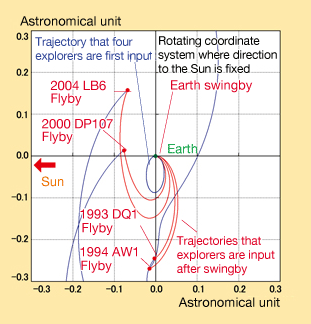TOP > Report & Column > The Forefront of Space Science > 2008 > Open Up New Routes in Outer Space
![]()

In deep space exploration, it is not easy to send multiple spacecraft to different targets by a single launch. This is because the launch timing and insertion trajectory of explorers are different for each target to be explored. This is a major restriction peculiar to deep-space explorers, when compared to earth-orbiting satellites for which 杜ultiple payload launches・by a single launch have become common lately. The trajectory shown in Fig. 3 is designed to mitigate this restriction. A total of four explorers are launched at one time and input in the same trajectory simultaneously. By arranging swingby conditions for each explorer as it approaches the earth a year later, each one can be inserted into its own trajectory by swingby. The four explorers can perform flybys past different asteroids a year later. The aim is to put several explorers, originally on the same trajectory, onto different trajectories. With earth swingby, this arrangement can be achieved with almost no propellant consumption. Of course, there are limits to the area where explorers can deployed with a single earth swingby, and therefore we lack complete freedom to select target bodies. Nonetheless, we have more options than with cases where explorers are inserted into individual trajectories at launch. 
Conclusion Mankind has launched a number of deep space explorers until now. Trajectory design or mission design has played a critical role in every mission. In the not-so-distant future, more explorers or spaceships carrying people will go into outer space and return. In that era, the trajectory that a space ship flies will be called a 吐light route.・Opening up new flight routes in outer space is my job. Yasuhiro KAWAKATSU
|
|||||




